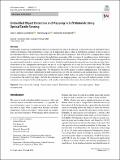Embedded Object Detection and Mapping in Soft Materials Using Optical Tactile Sensing
Author(s)
Solano-Castellanos, Jose A.; Do, Won Kyung; Kennedy, Monroe D.
Download42979_2024_Article_2731.pdf (2.198Mb)
Publisher with Creative Commons License
Publisher with Creative Commons License
Creative Commons Attribution
Terms of use
Metadata
Show full item recordAbstract
In this paper, we present a methodology that uses an optical tactile sensor for efficient tactile exploration of embedded objects within soft materials. The methodology consists of an exploration phase, where a probabilistic estimate of the location of the embedded objects is built using a Bayesian approach. The exploration phase is then followed by a mapping phase which exploits the probabilistic map to reconstruct the underlying topography of the workspace by sampling in more detail regions where there are expected to be embedded objects. To demonstrate the effectiveness of the method, we tested our approach on an experimental setup that consists of a series of quartz beads located underneath a polyethylene foam that prevents direct observation of the configuration and requires the use of tactile exploration to recover the location of the beads. We show the performance of our methodology using ten different configurations of the beads where the proposed approach is able to approximate the underlying configuration. We benchmark our results against a random sampling policy. Our empirical results show that our method outperforms the fully random policy in both the exploration and mapping phases. The exploration phase produces a better probabilistic map with fewer samples which enables an earlier transition to the mapping phase to reconstruct the underlying shape. On both the exploration and mapping phases, our proposed method presents a better consistency as compared to the random policy, with smaller standard deviation across the ten different bead configurations.
Date issued
2024-03-29Department
Massachusetts Institute of Technology. Department of Mechanical EngineeringJournal
SN Computer Science
Publisher
Springer Science and Business Media LLC
Citation
SN Computer Science. 2024 Mar 29;5(4):372
Version: Final published version
ISSN
2661-8907
Keywords
Computer Science Applications, Computer Networks and Communications, Computer Graphics and Computer-Aided Design, Computational Theory and Mathematics, Artificial Intelligence, General Computer Science